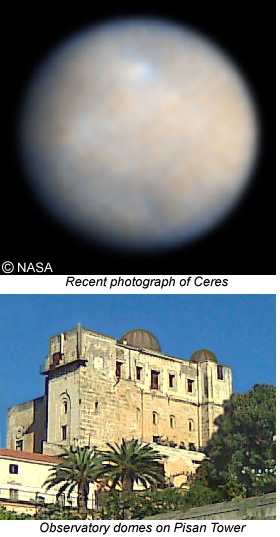...Best of Sicily presents... Best of Sicily Magazine. ... Dedicated to Sicilian art, culture, history, people, places and all things Sicilian. |
by Carlo Trabia | ||
Magazine Index Best of Sicily Arts & Culture Fashion Food & Wine History & Society About Us Travel Faqs Contact Map of Sicily |
Another such event occurred in 1801 when a Theatine priest named Giuseppe Piazzi discovered our solar system's largest asteroid, a dwarf planet named Ceres. (His original name, Cerere Ferdinandea, the second part honoring King Ferdinand of Sicily, was considered too political by the international scientific community.) Widely venerated in ancient Sicily, Ceres was the goddess of fertility, plants, flowers, the harvest and maternal love. To the Greeks she was Demeter, mother of Persephone, whose myth is closely linked to Enna in east-central Sicily. In Greece the planet is called Demetra. Piazzi discovered Ceres while working in the astronomical observatory atop the Pisan Tower of the Norman Palace (shown here). His results - he observed the tiny planet twenty-four times - were confirmed by several astronomers working in central Europe. In 1802, William Herschel underestimated the planet's size at a diameter of 260 kilometres, and in 1811 Johann Hieronymus Schröter overestimated it at 2,613 kilometres. We now know Ceres to be approximately 950 kilometres (or 590 miles) in diameter, comprising about a third of the mass of the asteroid belt. It is the only dwarf planet in the "inner" solar system; the others, including Pluto, usually orbit beyond Neptune. Indeed, Ceres was the first asteroid to be identified. It was initially classified as a planet, a status it reacquired two centuries later. Ceres is essentially a round rock coated in ice. Children are now taught that there are eight large "classical" planets in the solar system, Pluto having been demoted to the status of dwarf by the International Astronomical Union (IAU). The term itself was adopted in 2006. By definition, a dwarf planet is a celestial body in direct orbit of the sun that is massive enough for its shape to be controlled by gravitational rather than mechanical forces, though it cannot clear its neighbouring region of other objects. A dwarf is not a satellite (moon), though Pluto and some other dwarfs have moons of their own. A moon orbits around a planet and can be larger than a dwarf planet, which (as a suggested guideline) should be larger than 400 kilometres in diameter; the Jovian moon Ganymede, for example, is 5,268 kilometres in diameter. Currently, the known dwarf planets are Ceres, Pluto, Eris, Haumea and Makemake, though only Ceres and Pluto have been observed in sufficient detail to determine perfect conformity to the definition. However, Eris appears to be more massive than Pluto. It is possible that Pluto's moon, Charon, is actually a dwarf planet because it may revolve with Pluto around a common center of mass located midway between the two "twin" bodies. It is hypothesized that dozens, if not hundreds of additional dwarf planets exist in the most distant reaches of our solar system (in the Kuiper Belt). It is unlikely that any others as near to us as Ceres will be found. Ceres' orbit places it beyond Mars but closer than Jupiter. NASA's Dawn mission is scheduled to explore Ceres in 2015. About the Author: Architect Carlo Trabia has written for this publication and others. | |
Top of Page |
 Like the rest
of Italy, Sicily today suffers the effects of a very serious brain drain
caused by mediocre
Like the rest
of Italy, Sicily today suffers the effects of a very serious brain drain
caused by mediocre